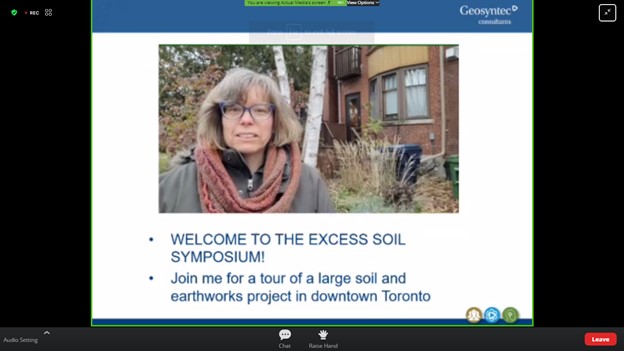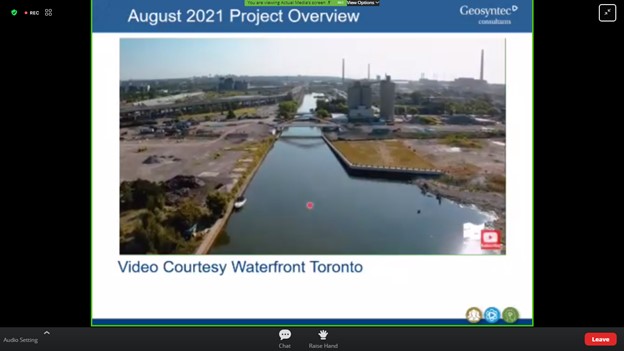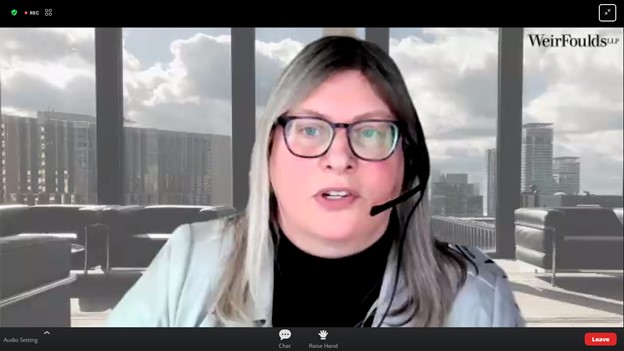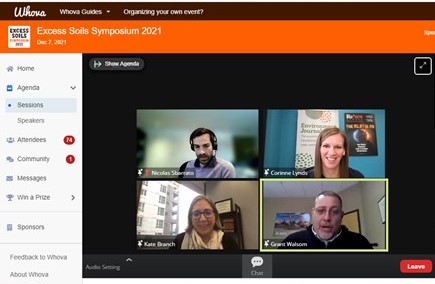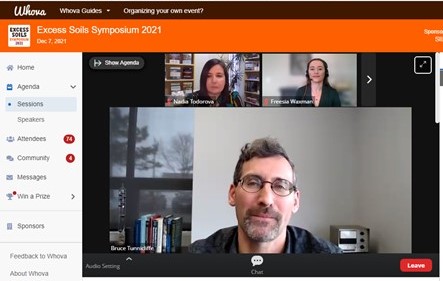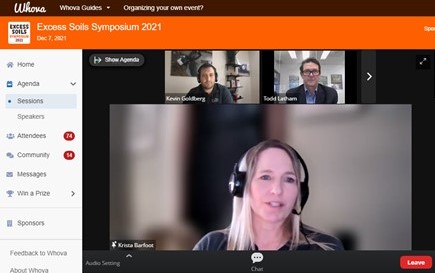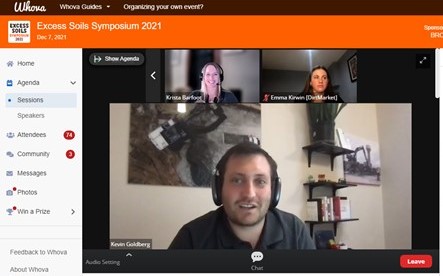Monday, June 30, 2025
On December 7, 2021, the Excess Soils Symposium provided an interactive platform for a virtual update on the business of excess soils and new regulations impacting construction and cleanup projects. The comprehensive conversation covered a range of new developments, including perspectives on project planning, environmental impacts, disposal costs related to new regulations, and the emergence of a circular economy for excess soils.
“This year, for the first time ever, the fifth annual symposium is crossing provincial borders and providing a national perspective on excess soil regulations,” said Corinne Lynds, content director at Actual Media, as she kicked off the symposium of almost 300 attendees.
Seasoned industry expert Andy Manahan from Manahan Consulting Services introduced the keynote speaker and provided some comments on the evolution of excess soils regulations. According to Manahan, new transformational projects are building upon the information shared at past symposiums, conferences and seminars. This multi-stakeholder information sharing within the industry has helped influence excess soils regulations. “An all hands-on deck approach is critical for a successful outcome,” said Manahan.
Port Lands redevelopment project
Meggen Janes of Geosyntec Consultants provided a keynote presentation on the major Port Lands project along the Toronto waterfront. Janes is a principal at Geosyntec and has more than 25 years of experience in risk assessment, remediation, and management of soil, groundwater, and sediment. She has reviewed and guided beneficial soil reuse projects totaling 2.3 million m3 of soil, readied Waterfront Toronto projects for the excess soil regulation, and is currently helping several municipalities get excess soil systems and processes in place.
“We started preparing soil procedures on this project in 2015 —that was before the excess soil regulation and before the proposed regulatory framework,” said Janes. “As the Port Lands project evolved, so did the regulations.”
The $2.5 billion redevelopment project involves creating a naturalized river valley—which, in itself, is a historic and significant undertaking. A crucial part of this project involves building new public spaces, roads, bridges, utilities, and structures to control water flow and manage sediment and debris.
Janes shared insight into the comprehensive planning process for this transformational project along Toronto’s waterfront. Figuring out the right course of action for the project involved multiple partners and planning meetings, with several drafts over several years. “It was standing room only,” she recalled of certain meetings. “Who knew that the excavation of excess soils could lead to such extreme controversy?”
The presentation provided a dynamic tour of the project through video, time lapse video and drone footage of the soil stockpiling for reuse, sediment processing sections, the newly excavated channel, historic buildings that are being preserved and redeveloped, the soil importation areas to create new lands (sourced locally to reduce greenhouse gas emissions), and the foundations for the new bridges that are being installed.
“Collectively, there is a wealth of information and knowledge amongst the attendees today and participants in the panel discussions and the regulatory brain trust,” said Janes. “I know that as an excess soils community we’ll work together to share information and champion implementation of the excess soil regulation.”
How new regulations impact the industry
Following the keynote presentation, the first panel focused on how new regulations impact the industry.
The panel:
- Janet Bobechko, WeirFoulds LLP and Provincial Excess Soil Engagement Group, Ontario Ministry of the Environment, Conservation and Parks
- Darren Cherniak, North Shore Environmental Consultants and a representative of the Environmental Services Association of Alberta
- Matt Gardner, Willms & Shier Environmental Lawyers LLP
- David Hodgson, Malroz Engineering Inc.
- Denise Lacchin, Golder Associates and member of Qualified Persons Committee of Ontario – Excess Soils
Bobechko discussed Ontario’s ground-breaking On-Site and Excess Soil Management regulation, which takes effect on January 1, 2022. The early launch of the Excess Soils Registry is providing the construction and soil management industries a full month to learn the system and file notices in advance of the new requirements in order to ensure obligated parties are complying with the new regulation.
The Excess Soil Registry is a major step forward in protecting the environment and supporting industry in Ontario. By tracking the reuse and disposal of excess soil, authorities can make sure clean soil is treated as the valuable resource it is, while ensuring that contaminated soil is properly disposed of – reducing the amount of waste that goes to landfill.
The new registry is also expected to make it easier for the public to find information about construction and excavation activities in their communities, as well as the movement of excess soil throughout the province through a searchable database of notices.
The registry was designed to meet both the regulatory requirements and integrate with existing business practices, but there will be challenges ahead for some in terms of adopting to the new system.
Bobechko also provided a look at the top issues of concern from industry, including sufficiently reviewing soil definitions and requirements, important definitions relevant to the new regulations, including the requirements of a project leader or site operator, the role of a qualified person (QP), etc. She emphasized the importance of good contracting that involves technical detail. “It’s the provisions in a contract that guide a successful project.”
Providing a Western point of view, Cherniak discussed the Alberta government’s site rehabilitation program that’s providing $1.7 billion toward the cleanup of old and inactive oil and gas wells. He provided insight from the perspective of an advisory committee member of this program as to what funding designations have been approved and what has been accomplished so far.
From a QP perspective, Lacchin said that she has been reviewing the new excess soils regulation for the past two years. She emphasized that no two sites are alike and course of action depend on key variables. In this new landscape, how can owners reduce costs? She recommends early planning and reusing as much as possible.
As an environmental litigator, Gardner warned of the risk factor and legal liability associated with the new regulatory regime. He stated that the same types of Excess soil is deemed waste in Ontario under the new regulation unlesss and until the requirements are fulfilled and assigned for reuse. “With all types of wastes, whether in Ontario or or other provinces, there are two types of liabilities: regulatory liability and civil liability,” stated Gardner.
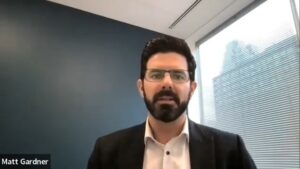
Both can apply just as they do to waste as they do to excess soils. Regulatory liability can include orders and prosecutions that are punitive in nature (even fines and jail time). He also warned of enforcement mechanisms that are coming into force. Civil liability can include lawsuits between parties. Plaintiffs usually seek damages but can also seek injunctive relief.
Gardner also referenced a case for recommended reading on excess soils litigation. To read about it, click here.
Hodgson said he has been an early adopter of excess soils best practices and recommends a multidisciplinary team to address excess soils projects. From a geotechnical perspective, he pointed out the many considerations to factor in when determining how soils can be reused and opportunities to apply less conventional approaches, such as geogrids.
Regional updates on excess soils standards
The second panel provided regional updates on excess soils standards.
The panel:
- Kate Branch, Core6 Environmental and British Columbia Environment Industry Association
- Nicolas Sbarrato, WSP Canada
- Grant Walsom, XCG Consultants Ltd. and Ontario Environment Industry Association
Branch provided an overview of British Columbia’s upcoming changes to legislation managing soil from industrial sources. She said it will be interesting to ese how B.C. finds the “sweet spot” between introducing new regulations and managing the cost of compliance when it comes to excess soils.
Sbarrato shared the experience so far with Quebec’s soil protection and contaminated sites rehabilitation policy action plan and site characterization guide, and new regulations on tracking contaminated soil. He pointed to the ongoing disconnect between the realities in the industry and the new excess soil standards. However, he said the construction industry is rising to the challenges with innovative strategies and new technology.
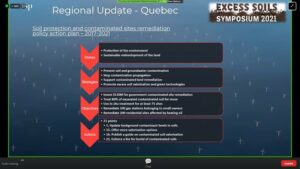
When it comes to Ontario’s Reg 406/19 and the recent discussions and feedback from industry working groups Walsom indicated that the industry is adapting and the environment ministry is working to address questions and comments, even in the face of limited resources due to the ongoing pandemic.
“Overall, the response has been positive, but like anything, change is difficult. It is my understanding that there has been some minor pushback and the MECP works hard to address the concerns,” said Walsom.
Walsom also pointed to the Beneficial Reuse Assessment tool (BRAT), which has been developed to allow for the development of site-specific standards at a reuse site, as a great tool for assessing excess soils characteristics and reuses, and for mitigating risks.
Business of excess soils
The third panel, which was moderated by Nadia Todorova, executive director of the Residential and Civil Construction Alliance of Ontario (RCCAO), explored current trends in the business of excess soils.
The panel:
- Freesia Waxman, WSP Canada
- Bruce Tunnicliffe, Vertex Environmental
- John Hibbard, Tervita Corporation and Secure Energy Services
Waxman, a self-proclaimed excess soils champion, provided an overview of the new trends related to the movement of soils between provinces current update on interprovincial considerations and the far-ranging implications for her clients at WSP Canada. “Nationally, there’s a lot of change taking place,” said Waxman. “The drivers are to stop soil from going to landfills, stop moving outside of regulatory limits and provide more transparency to the public.”
She also pointed out the similarities of the requirements in Quebec and Ontario and the evolution of trends in both provinces, and the impact to the bottom line for the construction industry. She said the experiences in these two provinces will be informative in terms of lessons learned to the excess soils industry in B.C., which is implementing new measures next.
According to Tunnicliffe, new excess soils regulations are long overdue and he’s happy to see soil reused and not disposed as waste. There are several emerging opportunities for contaminated soil recovery, said Tunnicliffe. He emphasized that bioremediation is more cost effective than hauling soils to landfill and paying tipping fees. He also pointed to the environmental benefits of removing tens of thousands of dump trucks from Toronto roads. His sophisticated engineering calculation example of the significant economic and environmental benefits is worth watching.
Hibbard discussed the cost of compliance in Western Canada and industry trends. Representing one of the latest firms in the west moving soil, he is well versed on soil regulation and how it’s working in various jurisdictions. He sees a lot of differences in terms of regulations and trends in the industry, which is dependent on the suppliers available (treatment options and number of facilities). According to Hibbard, Alberta business is very busy, while Saskatchewan is less so. And soil movement has been picking up in B.C. as is evidenced with several trucks in transit. He also discussed the need to research specific treatment facilities for sludge versus solids and to set aside enough time for planning on the client side of things to implement systems such as ponds and fill projects.
Best practices and new solutions
Finally, the fourth panel, moderated by Todd Latham, president of Actual Media, wrapped up the symposium with insight into new solutions and technologies that are helping to guide best practices in the industry.
The panel:
- Krista Barfoot, Stantec
- Warren Croft, GHD Group
- Emma Kirwin, Dirt Technologies and DirtMarket.ca
- Kevin Goldberg, SoilFLO
Barfoot emphasized the importance of advanced strategic planning for successful project outcomes using diverse geographic references. She recommended weaving excess soils obligations into the project delivery framework and carefully vetting the QP for project teams.
When it comes to contracting, Barfoot pointed out how to overcome challenges, such as clearly identifying the regulatory requirements within the roles and responsibilities of the various parties contracted to deliver the works. She recommends the development of special provisions that detail the obligations of the various parties for: soil quality assessment and documentation; soil management and handling; hauling and tracking requirements; and, records retention.
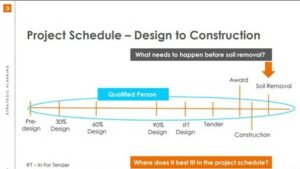
Croft remarked on the innovations in the technical aspects of drilling and sampling. He provided a comprehensive overview of best management practices to take during the sampling process, including:
- Confirming the roles/responsibilities are clear, and that the Project Leader and QP have reviewed the proposed approach
- Ensuring the SAP include all of the COCs identified in the Assessment of Past Uses, including the minimum analysis referenced in the Rules
- Finding out if the volume of soil that will be excess known at the time of sampling and determining whether topsoil and native soil be separated to two different receivers.
He also advised being aware of the sampling and whether it includes mSPLP analysis at the minimum frequency specified in the rules. He noted that this analysis has been missed in many sampling programs.
Meanwhile, Kirwin emphasized that technology enables construction teams to access soil reuse opportunities. She is excited about the new digital marketplace for soils. Providing access to pre-planning programs and soil reuse opportunities allows for cost savings and supports regulatory compliance. “Soil reuse promotes a circular economy and allows us to treat soil like a resource, not waste,” said Kirwin.
Goldberg discussed best practices for excavation and soil movement through tracking systems. He encouraged attendees to look on the bright side of new regulations, which will result in “transparency and better efficiencies in the industry.” He also shared the successful results of a project that involved importing one million cubic meters across seven contractors and 16 different source sites. Goldberg’s SoilFLO system enabled the following efficiencies:
- Data Standardization – hours eliminated previously spent distributing, collecting and reconciling; reduced testing and consultant costs through site delineation; and, quicker access to funds from the developer with immediate progress reporting.
- Cost Savings – standardized hauling records for each source site and contractor; site specific storage for all soil characterization and on going samples; communication between flaggers at each end through load notes; etc.
- Liability Reduction: load verification from source site; red flags attached to any load in excess of its estimated time of arrival; and, ability to deactivate any purchased ticket that went unused
The expert information presented at the symposium will help project managers, environmental consultants, and industry stakeholders from across Canada enter the new year well informed and ready to optimize project management while staying in compliance.
To watch the the complete Excess Soils Symposium 2021 videos, visit:
To inquire about being a speaker at ESS 2022, contact Connie Vitello at: connie@actualmedia
To inquire about being a sponsor of ESS 2022, contact Jackie Pagaduan at: jackie@actualmedia.ca




